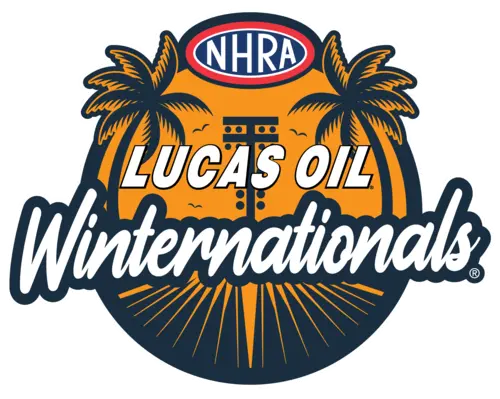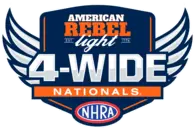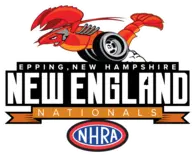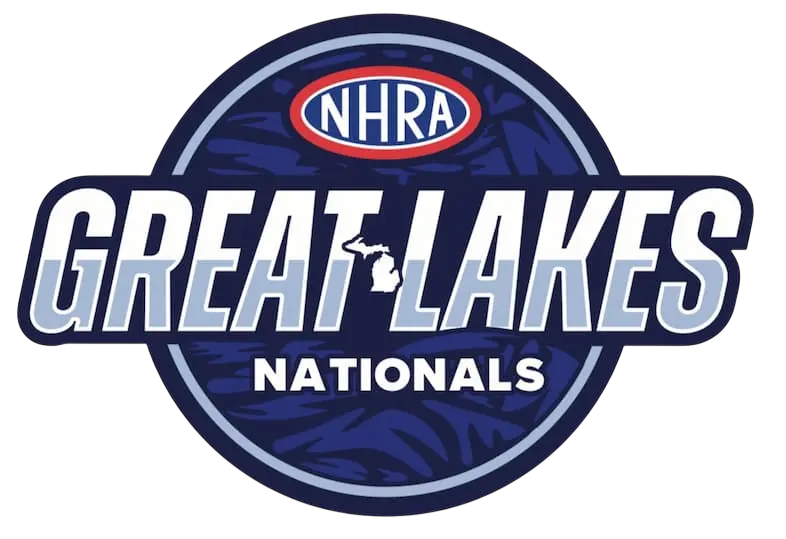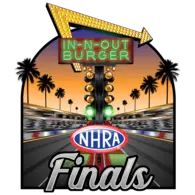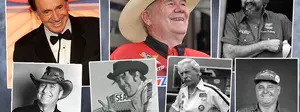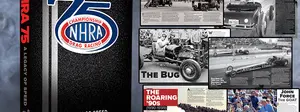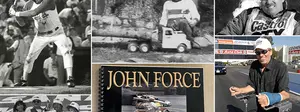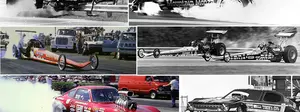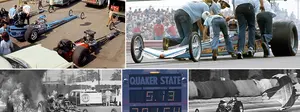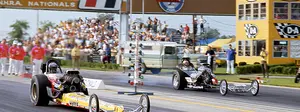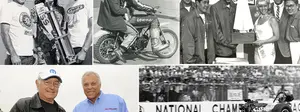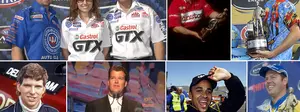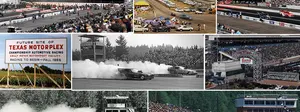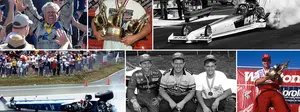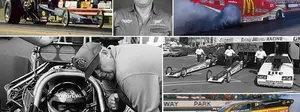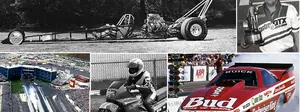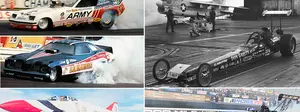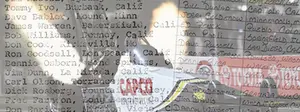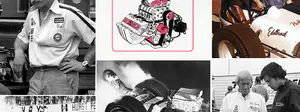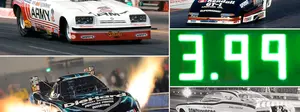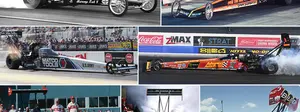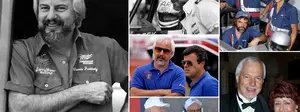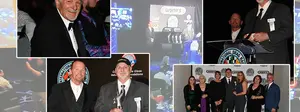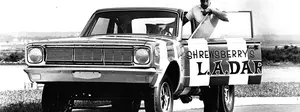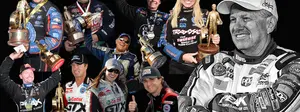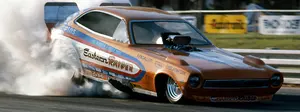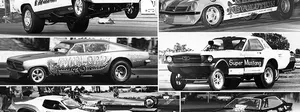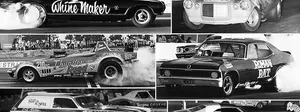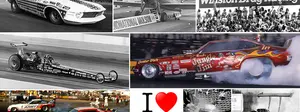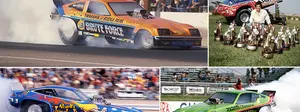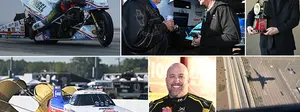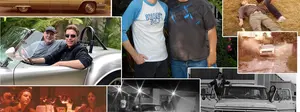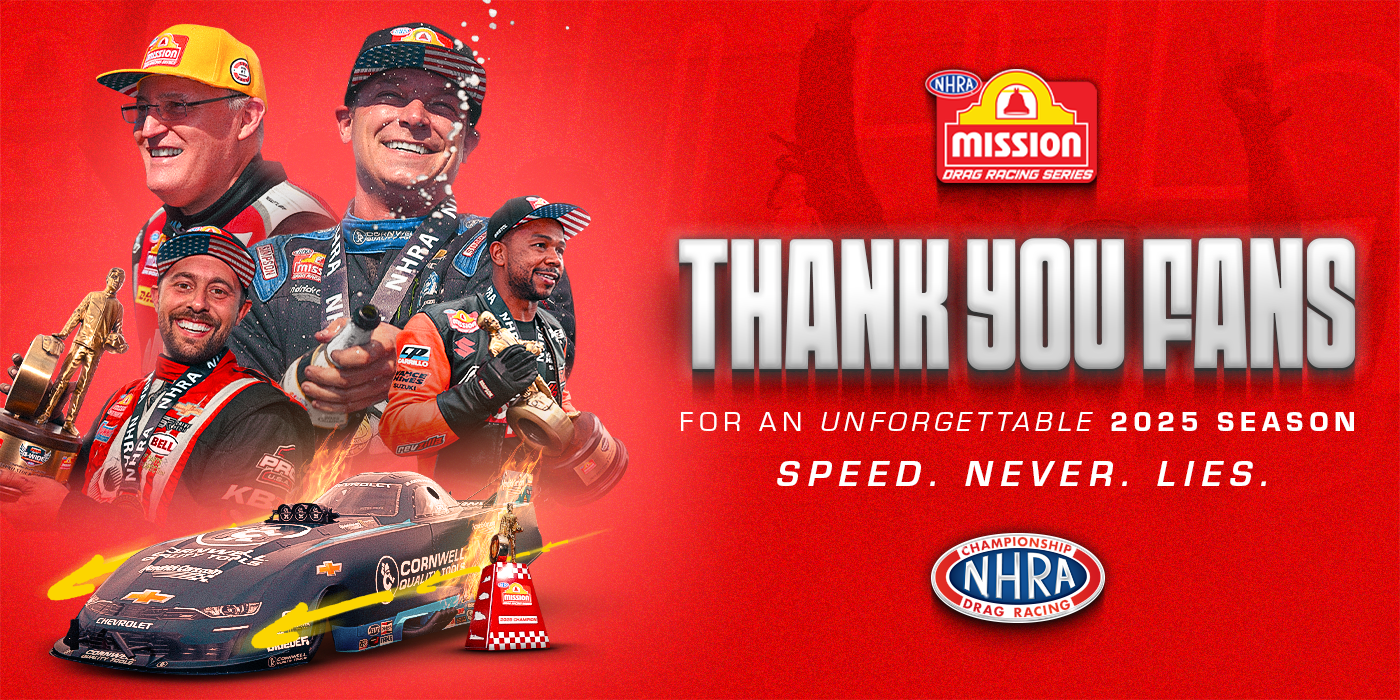

Larry Minor was a major player

Larry Minor was a racing success long before he became known to NHRA fans as a team owner for world champions Gary Beck, Dick LaHaie, and Cruz Pedregon, as well as nitro legends Ed McCulloch, Shirley Muldowney, and Frank Hawley in the 1980s and ‘90s, and played key roles in the drag racing careers of Larry Dixon Sr. and Jr., Tony Pedregon, Cory McClenathan, and Mike Neff, feats for which he is well remembered by dragstrip devotees. For more than 30 years, Minor thrived on motorsports competition from the desert to the sands to the asphalt quarter-mile.
We lost Minor last week after a long period of ill health, and even though his dragstrip exploits ended more than 30 years ago, he’s still fondly remembered by those whose careers he helped forge or resurrect.
Off-road success
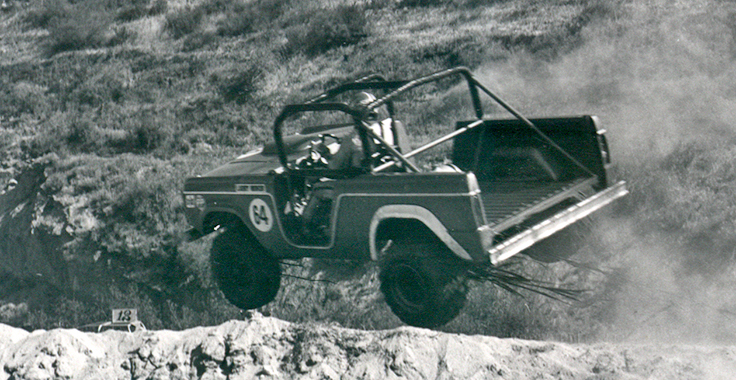
Minor grew up in Hemet, Calif., where the family grew potatoes through their Agri-Empire business, but he became enthralled with motorsports competition as a teenager after joining the Hemet Jeep Club in 1962. He won the 1963 New Year’s Buttercup meet in a 409 Chevy-powered Jeep, and over the next two years, he won a number of California Top Eliminator races in places like Bakersfield, San Jacinto, Pismo, Glamis, and in Fallon, Nev. In 1965, he and fellow Hemet Jeep Club member Harry Bushert helped create an unlimited four-wheel-drive class and the following year he debuted a fiberglass-bodied Jeep with a 352-cid small-block Chevy gulping nitromethane through a 6-71 blower. Minor’s “Flower Power” Jeep dominated the unlimited class for the next four years before he switched to a rear-engine Top Fuel dragster with a 500-inch aluminum Hemi that was unbeatable in the latter part of the 1970s.

When Ford developed its Bronco truck in the mid-1960s, company representatives came to Hemet to watch the local races and ended up offering Minor a factory ride. Minor was also a successful off-road racer, teaming with Rod Hall to win the inaugural NORRA Mexican 1000 in a stock 4-WD Jeep and teamed up again in 1969 in a Bill Stroppe-prepared Bronco. It remains the only four-wheel-drive truck to ever win the Baja 1000 event. “I was still just in my 20s, and here I was going to be working with Holman & Moody and Bill Stroppe,” he reminisced in a 2004 interview with NHRA National Dragster. “I also got to meet Mickey Thompson, Parnelli Jones, and many of my other idols.”
Kicking asphalt
Minor had already dabbled in asphalt drag racing, too, driving a ‘56 Ford and then a ’57 Chevy at Colton Dragstrip, and decided in the late 1970s that it was his next mountain to conquer.
“I've always had the desire; I like speed and going fast,” Minor told “Big Rich” Klein in a 2023 podcast. “I've always had the desire to go for asphalt racing. Sherm Gunn built my first dragster in the fall [of 1977], and I wanted to drive, but I didn't have time to get my driver's license, and I wanted to run the Winternationals that were coming up. My longtime friend and sand engine builder Jack Bayer says, ‘Well, I know Larry Bowers real well.’ "
Unfortunately, Bowers crashed during pre-Winternationals testing at Orange County International Raceway.
“He smoked the tires and stayed in it and then hit the guardrail and then went to the other side of the track and hit the other guardrail, went upside down, [almost] threw him out of the car, broke both arms and leg or two, and it was a mess,” Minor recalled. “My family says, ‘Larry, you'll never drive one of those cars,’ but I still wanted to race, so we rebuilt the car, and that's when I got Larry Dixon [Sr.] to drive.”
Dixon was just about winding down his Top Fuel career after years of success in a Chevy-powered dragster.
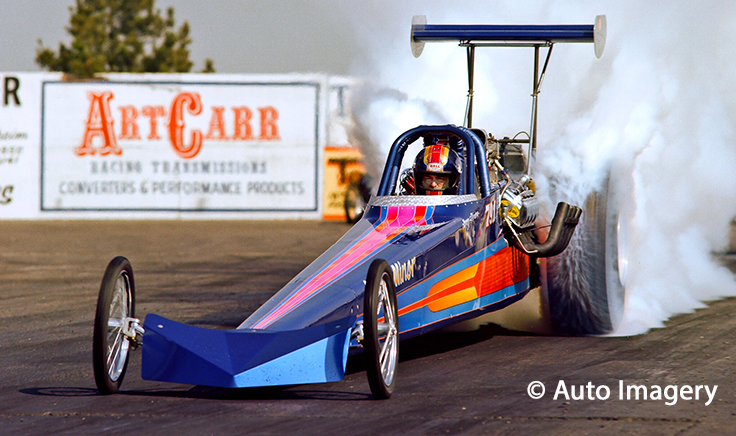
“He was kind of done with the family car, basically,” said the late Dixon’s son, three-time world champ Larry Jr. "And then that opportunity presented itself, and he got in the car and raced half a season of ‘78 [reaching the semifinals of the U.S. Nationals] and then did the full season in ‘79, and I think that was enough for him. He didn’t really like to travel, and Larry kept the car back east, where they ran Division 1 and 2. In 1979, they almost won both division championships, but there was a rainout that put both of the season finales on the same date, and he had to choose one. He won the Division 1 race [Englishtown] and finished first in Division 1 and second in Division 2.”
(Interestingly enough, Minor also opened the door to Dixon Jr.’s career, hiring him to wrench on Minor’s personal Top Fueler in 1986. Future world champion tuner Mike Neff also got his start with the Minor organization.)
Enter Gary Beck
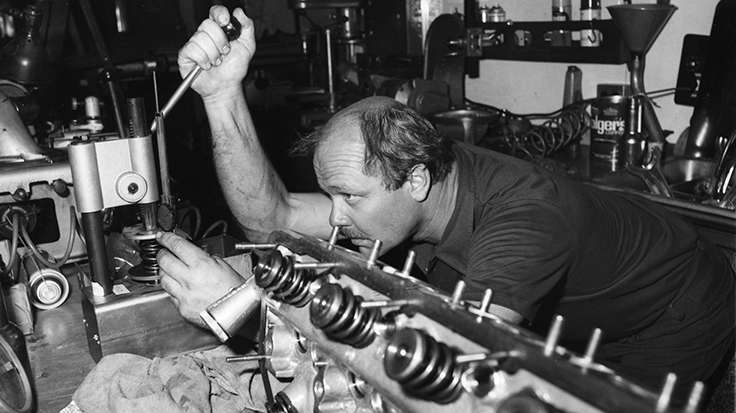
With Dixon Sr. opting out of continuing but Minor still eager to race, he began looking for a new shoe and came across Gary Beck in an almost backward fashion.
Beck, who had won the Top Fuel championship in 1974, finished second to Don Garlits in 1975, and third behind Richard Tharp and Frank Bradley in 1976, had failed to make the Top 10 in 1977, 1978, or 1979 as he and partner Ray Peets ran their Thrush-sponsored dragster, but Beck had not won a national event since the middle of the 1976 season.
Beck tried to recruit Jim Wright, the longtime shop manager at KB Racing Engines, who had been tuning Minor’s Dixon-driven car. Instead, Wright suggested to Beck that he join the Minor team. NHRA Competition Director Steve Gibbs had already recommended Beck to Minor, counseling that it would be the next step to competing for national event wins and world championships, so Beck stepped into the cockpit. Beck sold one of his cars to Minor so they had two cars, which would facilitate Minor’s own step into the cockpit a few years later.
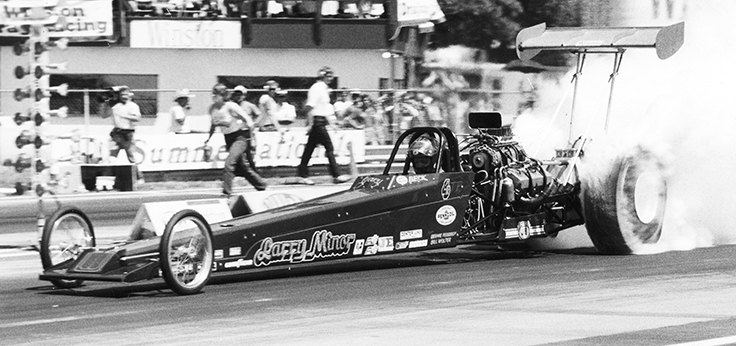
It didn’t take Beck long to get back to the winner’s circle, winning at the 1980 NHRA Cajun Nationals, the tour’s third stop, after Jeb Allen crossed the centerline against him in the final, to hand Minor his first major drag racing accolade.
The following year, Beck was in the title hunt with wins in Columbus and Englishtown before Minor and Wright had a falling-out midseason. The team soldiered on without him and still almost won the championship. In what has become a memorable moment of championship drama, Beck battled Allen to the wire at the NHRA World Finals. Allen lost early, and Beck made it to the final, where he could win the championship if he A) won the final, B) set low e.t., and C) set top speed of the meet.

Beck defeated Dwight Salisbury in the final, accomplishing Part A, and ran 5.573 to better Johnny Abbot’s 5.64 low qualifier e.t. to nab Part B, but his speed of 245.23 mph fell shy of Abbott’s 247.93 to hand the championship to Allen.
“Our car could always run good e.t., but we never had good speed,” Beck lamented.
All of that began to change in 1982 with the midseason hiring of Bernie Fedderly, who worked on the clutch program while Beck massaged the fuel system, and Minor contributed many great ideas to the team’s tune-up that would dominate the scoreboards for the next two years.
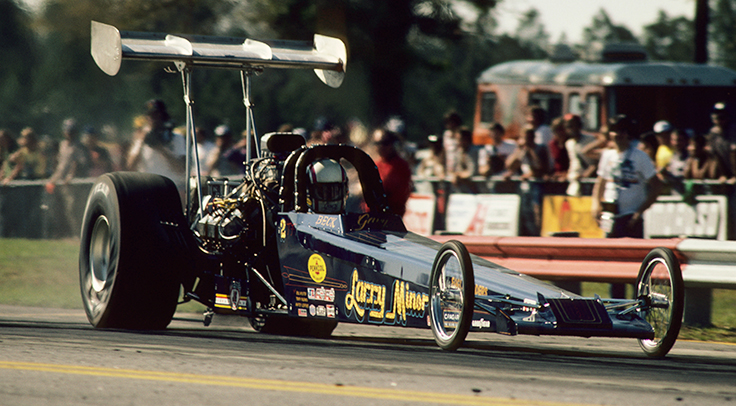
Beck’s long friendship with Pete Jackson allowed them to become the first to get his revolutionary barrel valve.
Minor recalled, “We drove down to Pete Jackson, and this barrel valve was $7,500 for one barrel valve, and back then you could buy a whole Enderle injector for probably $600, something like that. But anyway, we went through and put that barrel valve on, and then we went to live axle rear ends that are in the dragsters now.”
Although he’s more perceived as an owner with deep pockets than anything, Minor brought a lot more than that to the party, according to Beck.
“You could sit in on the nucleus of Bernie and Larry and I discussing how to make it quicker yet; we had some pretty good conversations,” Beck said.
For example, Minor’s off-road experience had taught him a lot about axles, and he had Steve Chrisman build them the first live axle rear end for a Top Fuel car, and also convinced the team they needed wider wheels.
Recalled Beck, “We had the good e.t.s, but we were also smoking the tires a lot, so Minor said we needed wider rims, which he knew about because of his sand drag racing. We had a lot of Cragar wheels — inner and outers — and before NHRA had a rule on rim width, we added another inch or more to the rim width, and that helped us out smoking the tires. That's where the e.t.s came from because the tires stayed flatter longer, and the car would launch hard."
At the 1982 NHRA U.S. Nationals, Beck ran the first sub-5.5-second pass, a 5.48, to qualify No. 1. It was their second straight of what would end up being a record nine straight No. 1 qualifying berths spanning the 1982-83 seasons.
With Minor in a second car, Larry Minor Racing ran 17 of the 18 quickest runs of 1983, and Beck won the championship by more than 2,000 points (10 rounds) ahead of Joe Amato.
Minor was happy to occasionally accept the role of blocker, which never seemed to work out for them, especially in Baton Rouge, La., in 1983, where they raced in the final. Minor’s plan was to shut off early and let Beck scream by for the win, but Beck’s mount chucked the blower belt, and despite tugging on the handbrake for all he was worth, Minor couldn’t get his car slowed enough and took the win light.

“We had a good laugh about it afterwards, and Larry was happy because his crew got the win,” said Beck.
Other battles, including the semifinals in 1983 Gainesville and the final in Baton Rouge and Columbus in 1984, were straight-up races, even if Beck did win them all. Minor also won the 1986 NHRA Mile-High Nationals.
Beck finished runner-up behind Joe Amato for the 1984 championship, but the team began a slow slide down the standings, to seventh in 1985 and then ninth in 1986, where Beck didn’t even finish the season, having been fired by Minor with two races still on the calendar.
“It was hard to stay on top for long, because Amato was coming on, [Don] Garlits came back, Darrell Gwynn got hot, Eddie Hill made his comeback … there were suddenly a lot of good cars,” said Beck. “Larry and I had a disagreement about my salary — it was always a contentious thing — and it finally came to a head.
“I loved racing for Larry, even if he was pretty frugal at times, even with his big potato business I remember one year him telling me and Ed he was going to pay us less, but he said if we invested in one of his potato crops, he’d give us the profits of that, so we did. I think we each gave him $10,000 to plant and harvest them, and he had one of his crew guys, Dick Veenstra, watering them. I think we each made $15,000 on that, so only $5,000 profit, but it was pretty funny how Ed and I suddenly became potato farmers for a year.
“I won 12 NHRA races and one IHRA race with Larry and won one NHRA championship, and we won the March Meet back-to-back in ‘84 and ’85, so there were a lot of good times. It was a good experience, and it was certainly good for my career.
“I was pretty sore for a long time about how it ended, but we patched it up eventually. I talked to Larry about two months ago when his birthday came up on May 5. I sent him a birthday wish, and he responded back, so we ended on good terms.”
Minor draws an “Ace”
Right after Beck won the 1983 championship, the whole team dynamic changed radically. Minor recalled, “I loved driving and making changes on the cars and things like that, but I didn't really have any desire to go get major sponsors or anything like that, but I was walking down pit road at Orange County at the [1983] World Finals, and these two guys came up, and I said, ‘Are you Larry Minor?’ I said, ‘Yes, sir, I am.’ [They said] ‘We're from Oldsmobile, and we want to get into drag racing, and we want to be with you.' ”
Oldsmobile obviously wanted a Funny Car for 1984, and Minor told them he didn’t have a car or a driver, but they promised the resources to put it together.
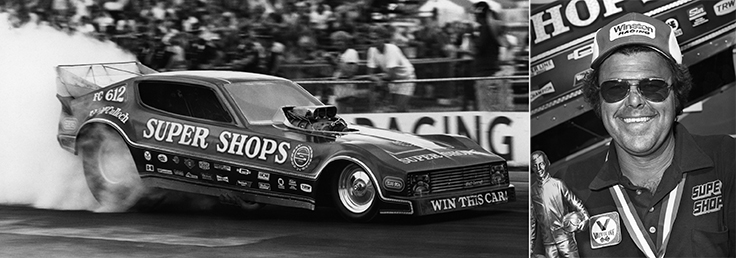
Like Beck before him, Ed McCulloch thought maybe his best days were behind him. He hadn’t competed on the national tour in two years and was working with former racing partner Ed Whipple in a steel rebar business and driving occasional match races for Jerry Verhuel. He hadn’t won a national event since driving the Super Shops car to his third Indy win in 1980. That didn’t stop Minor from calling “the Ace” after his business manager Holly Hedrich suggested him.
“I pretty much had figured that my days as a race-car driver or owner or anything else were done,” remembered McCulloch. “I have to give Larry credit for taking me into consideration, and ultimately hiring me, and we were together for a lot of years, so it worked out for both of us."
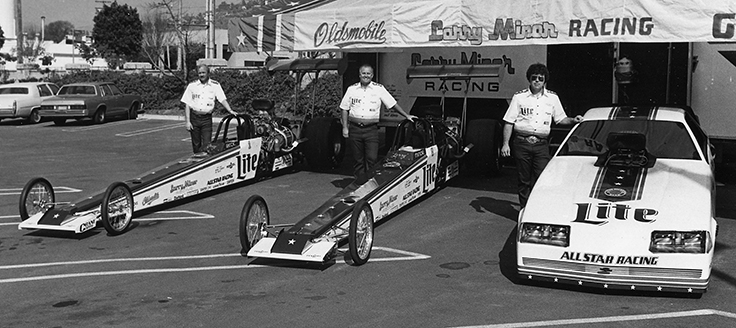
A week after signing McCulloch, more good fortune arrived when Miller Beer approached Minor about sponsoring his three-car team through its Miller Lite brand, which later morphed into Miller American and then Miller High Life sponsorship.
“It turned out really good,” Minor reflected. “Oldsmobile stuck with me for 14 years, and I had Miller for nine years, and that went away.”
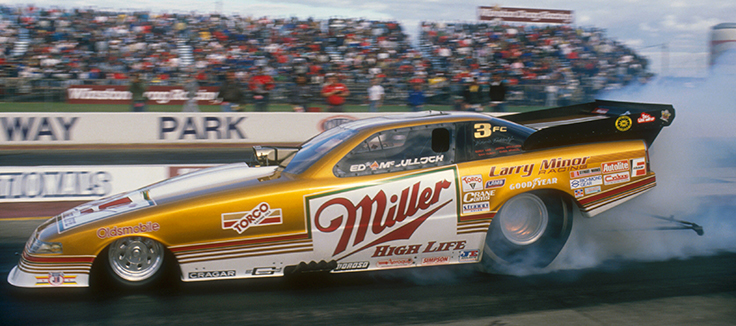
McCulloch never won a championship for Minor — finishing a best of third in 1987 — but scored 12 national event wins, including two in Indy in 1988 and 1990, once Fedderly switched from the dragster to the Funny Car. The Miller deal ended after the 1990 season, but Larry Minor knew Paul Pope, who owned Otter Pops popsicles, and it was through Otter Pops that Minor sponsored three-time Top Fuel world champ Shirley Muldowney to a Top 10 finish in 1990, which led to Otter Pops sponsoring two cars in 1991.

McCulloch drove the Otter Pops Funny Car in 1991, while Cruz Pedregon joined the team and drove the Otter Pops dragster at a dozen races, albeit with little success. McCulloch wasn’t happy either, but for a different reason.
“By that time everybody that I liked racing in Funny Car had left to go to Top Fuel: McEwen, ‘Snake,’ and Bernstein and all of those guys, and the only guy left over there to battle was [John] Force," he said. "Like those guys, I had started my career in Top Fuel, so I went to Larry and said, ‘I would really like to go race those guys again,’ and he says, ‘If that's what you want to do, we'll put Cruz in a Funny Car,’ so he signed off on it, and it worked out for both Cruz and I.”
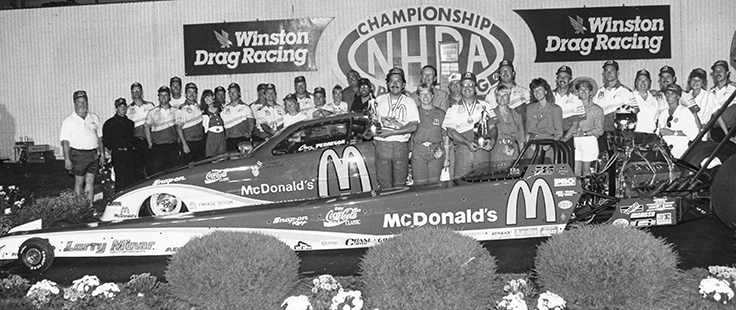
McDonald’s had come to drag racing, and they came to Larry Minor Racing in 1992, which was a banner year. Pedregon won the championship, and he and McCulloch enjoyed a rare double win at the U.S. Nationals, certainly one of the highlights of Minor’s team ownership.
“That was big for the entire team, and it was for me, personally,” said McCulloch, who became just the second driver (behind Prudhomme) to win Indy in both nitro classes. “I won my first Indy in Funny Car [1971], and my last in Top Fuel. I had a lot of success at Indy, and I can't answer why, other than the Good Lord was looking after us at Indy, but to win Indy in the Top Fuel car being my last Indy, that was pretty special.”

McCulloch finished fifth that year, also winning in Topeka and Dallas, and won his final event in Houston in 1993 before he and Minor parted company, much as it happened with Beck, and, again, the two eventually patched up their differences.
“I talked to Larry a couple of months ago,” he said. “We weren't on a regular basis, but we were friends, and I stayed in contact with his family, because I respect them, but it was just one of those deals for a while.”
The Cory story
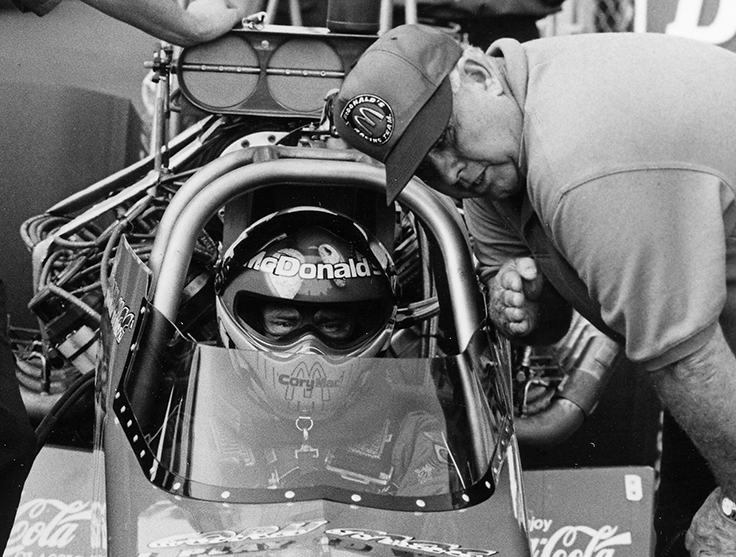
Minor didn’t stray very far on the alphabetical list to find McCulloch’s Top Fuel replacement, hiring privateer Cory McClenathan to shoe the car in 1994. As it had been with Dixon Sr., Beck, and McCulloch, Minor ended up rejuvenating Cory Mac’s promising but at-risk career.
“Larry heard that my parents and I were going to park our Top Fuel car after the 1993 season because we just didn’t have the funding,” recalled McClenathan. “Larry came up to me at a race and said, ‘Hey, how'd you like to drive the McDonald's car and work for me?’ At that time, he had two dragsters, and I thought he wanted me to drive the second car. That's when he told me, ‘I'm letting Ace go; I want you to drive it.' I felt bad because Ed and I were friends.”
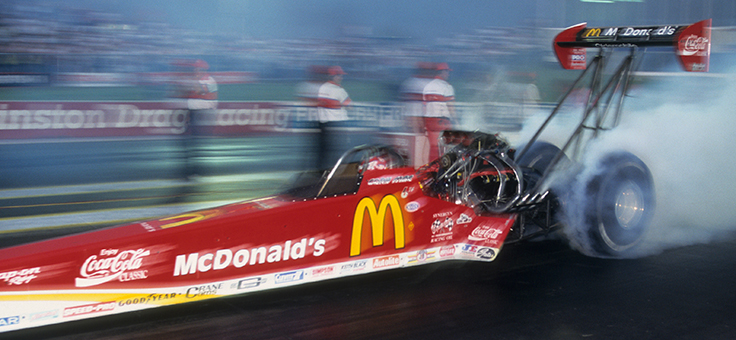
McClenathan had a great season, scoring two wins and finishing third in points, but it was his only year with Minor, who somehow lost the McDonald's deal to NFL coaching legend Joe Gibbs for 1995. McClenathan opted to stay with the sponsor and Gibbs instead of going back to the sidelines, and his career skyrocketed from there as he’d go on to win 39 more times in Top Fuel for various owners.
“Larry meant a lot to me; he really did,” said McClenathan. “If he didn’t hire me for 1994, I have no idea where my career would have gone. He gave me my shot, and look what happened after it. Without him, I might never have gotten started, so I'm crushed that he passed away.
“Over the last several years, we've gotten to know each other well. I even drove his sand cars a few times when he needed a driver. I’d tell him, ‘No charge. I'll be there. I'll do it. Let's have fun.’ He was really good to me. What a great, great person; the whole family has treated me like I'm part of their family forever, so I'm extremely grateful.”
A championship season with LaHaie
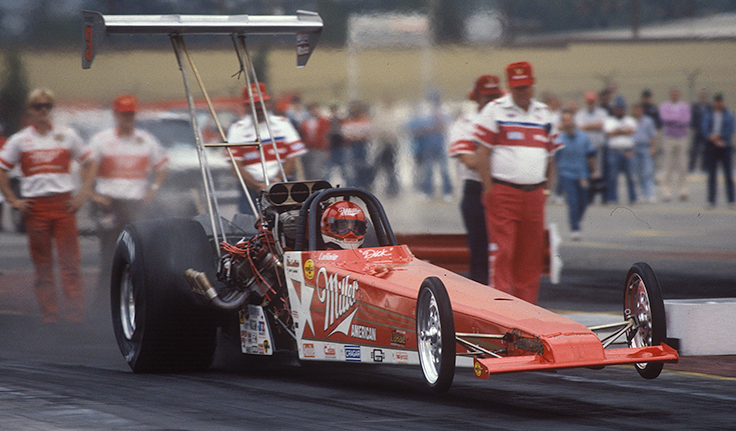
Backtracking a bit to fill in an important gap, after firing Beck in late 1986, Minor quickly pivoted to put Top Fuel veteran Dick LaHaie in Miller colors, although LaHaie owned and tuned the cars with daughter Kim and son Jeff. LaHaie, who probably did more with less than most for years, had not been a perennial championship contender — finishing a best of fifth in 1980 before a standout third-place finish in 1986 — but 1987 was his year, winning the title in a tight battle with Amato decided by just 42 points after a five-win season that doubled his career wins total.
LaHaie stayed with Team Minor/Miller, finishing third in 1989 and 1990 and ninth in 1991 before leaving the cockpit and the team to eventually tune Scott Kalitta to back-to-back Top Fuel championships in 1994 and 1995.
School's in for Frank Hawley
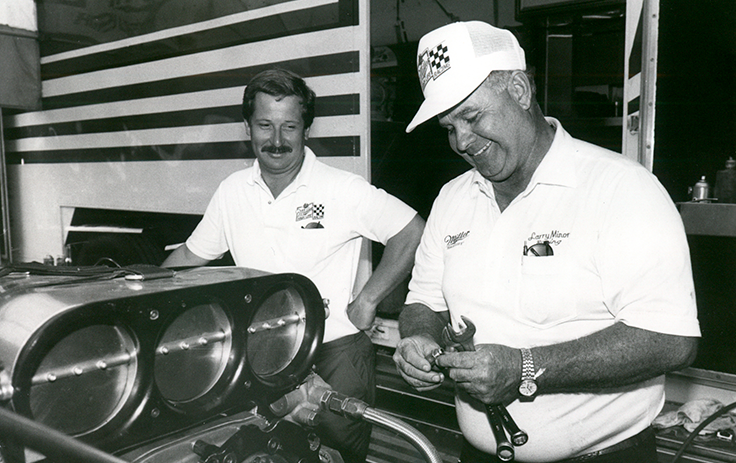
Two-time Funny Car world champ Frank Hawley was another to benefit from the “Larry Minor Career Expansion” program. Hawley was three years out of the saddle after a good run with the Chi-Town Hustler team when Minor came calling with an offer to drive a second Miller High Life dragster in 1988.
Hawley had opened his famed drag racing school in 1985 and was doing some announcing at NHRA national events. When Minor qualified No. 1 at the 1988 Winternationals, Hawley jokingly opined over the microphone, “That car is fast. I’d love to drive it.” Weeks later, Minor was on the phone offering to make that happen.
“[My wife] Lana took the call and told me, 'Larry Minor wants to talk to you about driving his car.' I thought she was just teasing me, of course, but I called him back, and he said, ‘I've had enough fun driving a car and I’m thinking about somebody else driving it. We're looking for people that have won some races before and might like to drive my dragster.’ “
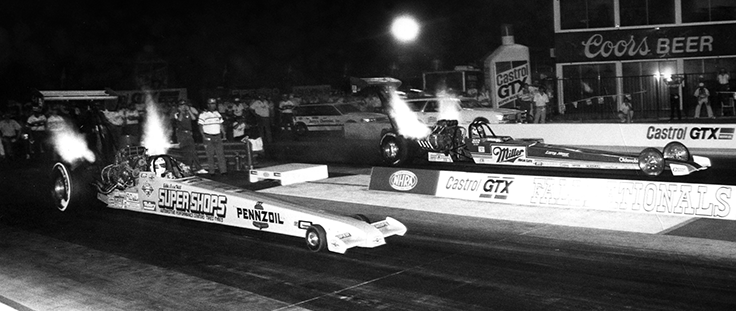
Hawley wasted no time agreeing, and the new team debuted in Sonoma and ran 17 races together over the 1988 and 1989 seasons. With Minor and Willie Wolter calling the tuning shots in 1988 and John Medlen twirling the iron in 1989, the car was a consistent top-half (and usually top-four) qualifier and reached two final rounds, in Phoenix in 1988, where they lost to Eddie Hill, and in Baton Rouge in 1989, where they lost to Gene Snow.
“We had a pretty good run there,” Hawley reminisced. “Larry treated Lana and I with such respect and was so gracious. Whenever we raced on the West Coast, he wanted us to stay with him and Sandy at the ranch there. Larry Minor was a gentleman. He was gracious and giving. He had a wonderful laugh and a great sense of humor.”
As mentioned previously, Shirley Muldowney drove Minor’s car in 1990 with the backing of Minor’s friend, Paul Pope of Otter Pops.
"He just thought it would be fun to put Shirley in a car with good funding. Larry called me and apologized for making that decision, but as it turned out, there would be something else in 1990," he said.
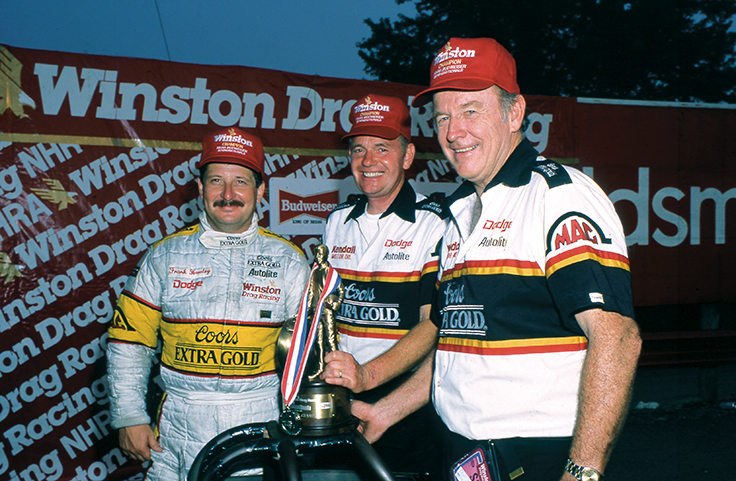
Shortly into the 1990 season, Darrell Gwynn’s fast-rising Top Fuel career ended in a horrible crash in England, and the Gwynn family tapped Hawley as the replacement driver for their Coors Extra Gold car, and, in one of the year’s wonderful feel-good stories, he would go on to win two races that year.
“I have no doubt that my time driving for Larry had some influence on the Gwynns’ decision,” said Hawley, who, previous to that, was known as a Funny Car driver. “I think you want somebody that's a little bit current, and everything contributes to everything else.”

Hawley remained friends with Minor over the years and saw him recently when some of Minor’s friends enrolled in Hawley’s driving school.
“Larry stopped by to visit and surprised me by bringing a box of my photo cards from the Miller car,” he said. “I surprised him by wearing one of my original Miller High Life team shirts that I had saved all these years. I was pleased it still fit!
“Here’s the story I always tell when people ask me about what kind of guy Larry was. He was one of the hardest-working guys anybody ever met. He told me the story of how he and his brother started with just an acre of land to grow potatoes, and they would sit on the side of the road in a pickup truck with a sign out selling their potatoes, and that turned into Agri-Empire.
“But when you see a guy with his own jet, you don't expect the guy to be a hands-on guy. One time when we were in Hemet, he asked, ‘Do you want to go to work with me tomorrow?’ And I said, ‘Yeah, it would be interesting to see what this is all about.’ He says, ‘Well, we're getting up at 4:30.’ We got up, and we were out of there at five, and he had a brand-new 7-series BMW, and we jump in this thing, and I'm thinking, ‘We'll go get us a latte, and cruise around and inspect all the worker guys,’ but we drive down this dirt road and we park, and he's got flashlights, and he opens up the trunk, and he's got muddy rubber work boots and shovels in there. He puts them on and we go out, walking down these rows of potatoes. He'd dig up a potato and look at it, and then plant it back in the ground and press the dirt down on it. And I said, 'What are we doing?' He says, ‘Well, you gotta know what the potatoes are doing. We can't wait till they get out of the ground. I gotta see what they're doing so we can figure out irrigation.’ And I said, ‘Larry, you’ve got a Learjet … don't you have somebody do this?’ And he said, ‘Ain't nobody knows more about these potatoes than I do,’ and that's what we did in the mornings, and I thought, ‘God, I love this guy.’ “
Shirley and Larry: Dog lovers unite
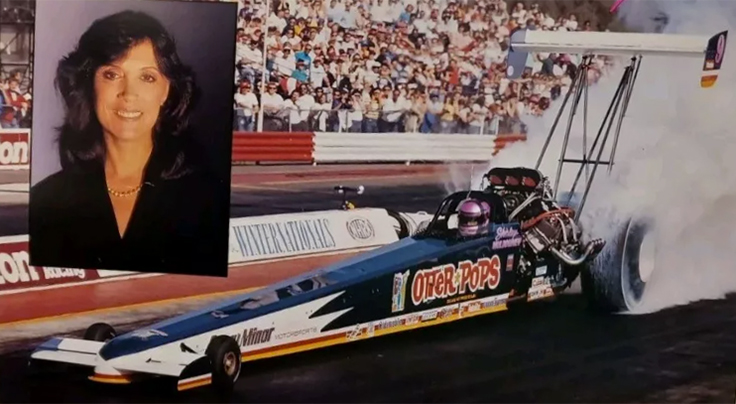
Despite winning the 1989 NHRA Fall Nationals, her first win since her terrible 1984 Montreal accident, three-time world champ Shirley Muldowney’s partnership with Performance Automotive Wholesale ended after the 1989 season, but along came Minor to offer her the ride in his Otter Pops car for 1990.
“He was great,” the drag racing legend told me. “I adored Larry. He was always good to me. One thing that we shared deeply was our love for dogs. He was very into animals, and he admired the fact that I loved dogs as much as he did. I have several copies of a write-up that was a beautiful tale about our dog, and it was really beautifully done, and Larry had it made up, scrolled, and bordered, and it was really a nice piece, and he gave me several copies of it, one of which I have mounted.”
Despite problems with the car’s balance, Muldowney won her fair share of rounds and finished in the Top 10 for the 11th and final time of her career. Her best outing was at the year’s second event, in Phoenix, where, just a few months after her triumph there the previous fall, she reached the semifinals and left on reigning world champ Gary Ormsby before the car went into a midtrack that caused her to cross the centerline.
“It was a great-looking car — it was long and very sleek; I loved it — but the motor was either too far forward or too far back [in the chassis], but it just was not a great balance," she said. "God bless him, Larry wouldn't leave it alone and kept the guys working on it. Overall, the car was a good car, and Larry provided me with good equipment, better than I had ever enjoyed prior to that.
“He was a great guy. He was very good for the sport, and he was a competitor, boy, when he was driving. The only thing you had to remember was if you were out to dinner, never order the rice: order the potatoes!”
Launching the Pedregons
Two-time NHRA Funny Car world champion siblings Cruz and Tony Pedregon both have Minor to thank for helping advance their careers.
Cruz was already an accomplished Top Alcohol driver with four national event wins when he first approached Minor.
Recalled Minor, “Joe Pisano said, 'I have this guy that could really be a good driver. He really wants to drive a Top Fuel car.’ Cruz showed up at my shop door one day and says, ‘I hear you're looking for a driver. I want to drive one of your cars.’ He says, ‘I'll work for nothing. I don't have anything to hold me back, and I have a Class 1 [driver’s] license. I can drive your diesel rigs and everything.’ So, I put a deal together with Cruz, and we became really good friends and won a lot of races.”
“There’s truth to that story, “ Cruz told me this week. ”Larry had always had veterans, you know, Gary Becks and Ed McCullochs, and I was just kind of a spring chicken right out of alcohol. I had met Larry at the ‘89 U.S. Nationals, just kind of a plant-the-seed scenario. The next year, I drove the Miner brothers' [Alcohol] Funny Car, and after Shirley leftMinor’s team, that opportunity opened up."
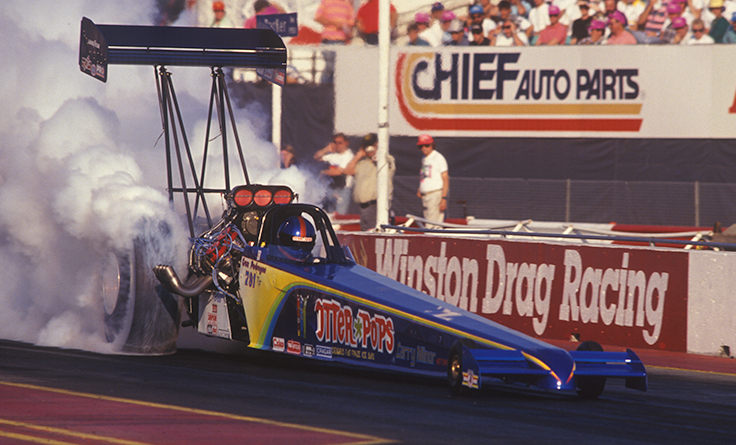
Pedregon drove Minor’s Otter Pops Top Fueler at 12 races in 1991, DNQ'ing three times and winning just three rounds, two of which came in Seattle, where he reached the semifinals after defeating legend Don Prudhomme and Cory McClenathan.
“I would have preferred to drive the Funny Car, but I drove the dragster through that one year and got to race against guys like ‘the Snake’ and ‘the Mongoose’ [Tom McEwen], which was unbelievable,” he said.
“At the Reading event in 1991, Larry told me that Ed had wanted to drive the dragster, and would I mind driving the Funny Car, and he could have knocked me over with a feather. I'm like, ‘I'd rather drive the Funny Car anyway,’ so that worked out, and we got the McDonald’s deal to start 1992. They say timing is everything, and I benefited from it all, from being around Ed and Bernie all those years.
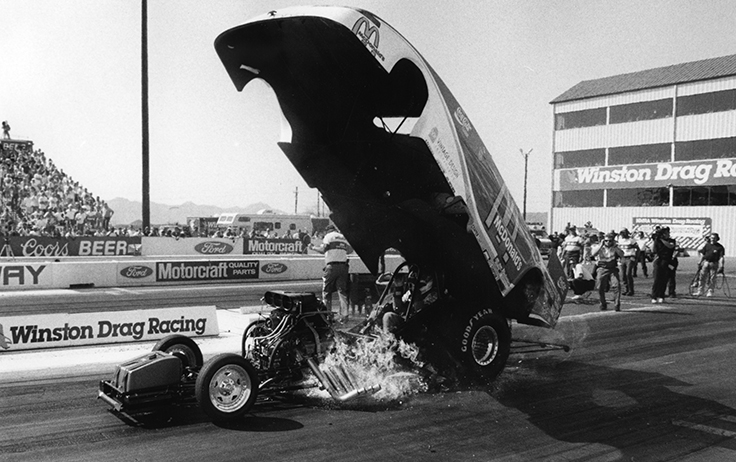
"We had a rough start to the year — it kept blowing the blower off of it — but once we put Lee Beard’s dragster combination in the Funny Car in Houston, it became a pretty well-oiled machine. We set the national record that year, and we were strong down the stretch and rattled off five wins in a row [Brainerd, Indy, Reading, Topeka, and Dallas] and, like they say, the rest is history. We beat Force for the championship and had some pretty good years after that."
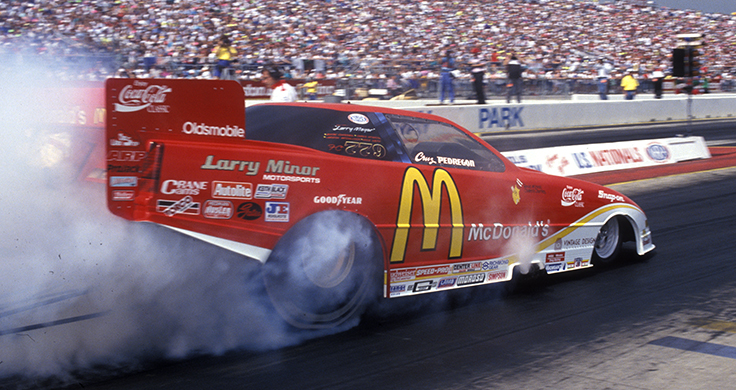
Pedregon won six races in 1992 — including the U.S. Nationals with McCulloch — and won the world championship in the McDonald’s Funny Car, won two more events in 1993 and three in 1994, Minor’s last season before Gibbs took over the sponsorship.
“We knew in the fall of ’94 what was happening with Gibbs getting the McDonald’s deal for ’95,” Cruz remembered. “We finished the year, and Larry asked me to stay with him, and I was torn, because I really like Larry, and I liked racing for Larry, because he's the one who hired me. But McDonald's was pretty enthusiastic and had deep pockets, and it would have been foolish not to pursue and go down that road, but it was awful and awkward for a while, and how it all went down. I liked working for Larry because he was a hard worker, too. Larry was very hands-on. He always knew the inner workings of the team, while Gibbs was way more hands-off.
“I don't know the details about how Gibbs got the deal, but it felt like to me the rug just got pulled out from under him. He still had all this equipment — it was good equipment; Larry always had top-notch equipment, and he didn’t sell one wheel to Gibbs; not a tire or even a jug of fuel, nothing — and he gave Tony the opportunity to drive for him and was the driving force behind Tony driving for John Force, because Larry felt like Tony was an up-and-comer like myself, and wanted to give an opportunity to Tony.
“[Leaving] put a strain on our relationship for a while, but we patched it up, and I’d text with him probably once a month or every other month, and I was there to support him and cheer him on when he was inducted into the [International Drag Racing] Hall of Fame in 2020, and he said our championship together was part of the centerpiece of his career, which was very touching to me.”
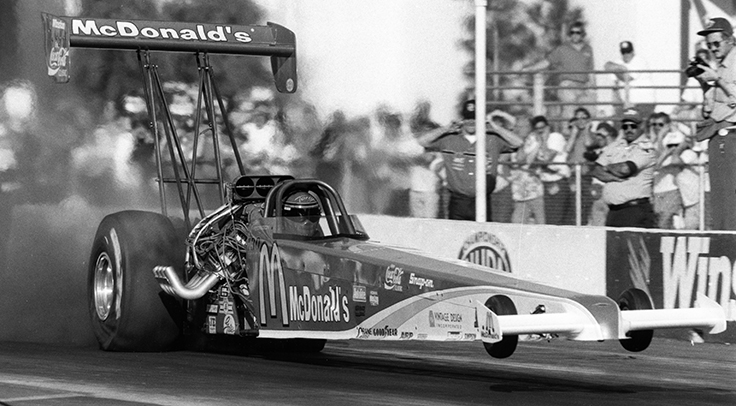
Brother Tony and Cruz were part of the McDonald’s team together when Minor hired Tony to drive his personal car — still branded with McDonald’s colors — starting at the 1992 NHRA Finals and through six events in 1993.
Tony’s only experience at the time was driving John Mitchell’s Montana Express A/Fuel Dragster — a car that was a stepping stone for guys like Larry Dixon Jr., Ron Capps, and David Grubnic — but through Cruz and through running some mutual events, Minor became aware of Tony. When the team’s main Top Fueler and Funny Car moved to Indianapolis, Minor opted to run the second Top Fuel car out of his Hemet, Calif., shop.
“It was just a bunch of his friends — a couple of farmers, his fabricator, people like that — and we just went to the races that he wanted to go to," Tony said. "I think Larry just wanted to enjoy tuning a car himself without the hustle and bustle and pressures of a super team.
“I was driving for Mitchell at a divisional race in 1992 when some local sportswriter told me that Larry was going to have a second dragster and was considering me to drive it; I had no idea. I was shocked but thrilled. I had met Larry through Cruz and later found out that Cruz had put in a good word for me.
“He wanted to run the Finals that year, so we put together the second car but only had one day to get cross-licensed for Top Fuel at Bakersfield. It was a thrash, but we got it done.”
Tony only drove for Minor through 1993. In 1994, he drove a Top Fuel car for former Funny Car racer Nelson Lengle (Sno-Town Shaker) that used an engine donated by Minor out to Cory Mac’s car, and when Cruz opted to go with Gibbs in 1995, Minor put Tony in the former McDonald’s Olds Cutlass, rebranded as Geronimo.
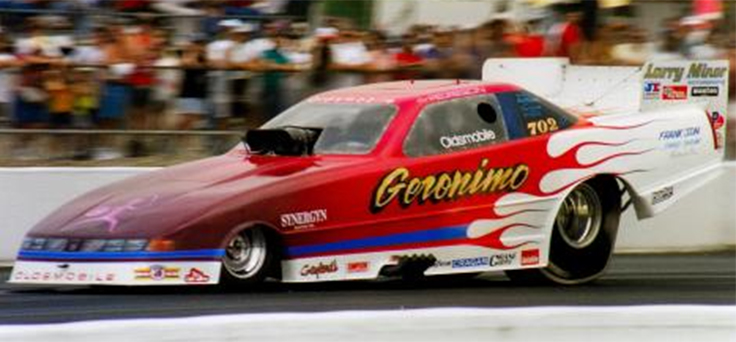
“I think the incentive for him to run a Funny Car was because he wanted the chance to beat Cruz,” Tony reflected. “It was a good car with good parts. Larry had a very competitive nature about him and was driven for results and could be hard on his drivers, but he was never like that with me, and it’s because of Larry that I ended up driving for John Force in 1996.
“We blew the car up at Indy — actually threw the body off of it — and I knew Force had a spare Plueger car and body and wanted $25,000 for it. That was more than Larry wanted to spend, so I got a friend of mine to pitch in half, and that's how we bought that car that ended up going to Bill Blomgren, but I know that Larry put in a good word for me with Force.
“When I heard that John Force was going to run a second car in 1996, I told John that Tony should be his driver,” Minor said. “I wanted to make sure that Tony had gotten himself a secure ride before I retired from drag racing.”
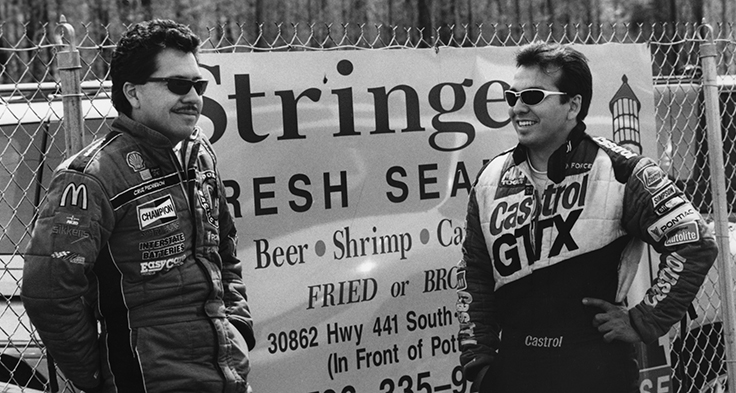
Tony was originally scheduled to carry on with Blomgren before a Thanksgiving 1995 call from Force offering Tony the chance to drive a second Castrol GTX Funny Car. He won the 2003 championship with Force then went out on his own in 2004. Minor remained a big supporter — always there to field Tony’s questions about team ownership and even family matters — and Tony rewarded him by putting a Larry Minor Racing decal on his new Quaker State Funny Car in 2004.
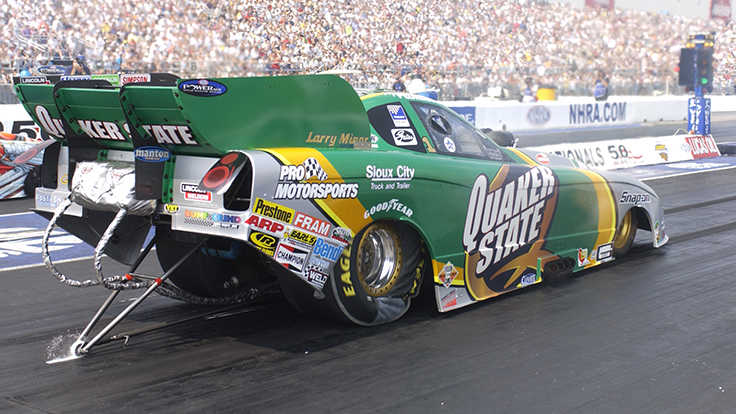
“I didn’t have a lot of sponsors on that first car, and honestly, putting Larry’s name on my car was for two reasons: to thank him and to get into Force’s head a little bit. I knew John was going to walk by my car and only see a couple of logos. I told Larry, ‘When John sees my name on there, he’s not going to think much of it, but if he sees your name on there, there’s going to be a little more respect,’ and Larry started laughing, so I always kept Larry's logos on my car.
“I always realized that Larry thinks big. He always did. He was comparable to a Don Schumacher or a Roger Penske. I wasn’t always able to execute everything that he would suggest, but I would call him for that reason, and no matter what the question, I’d always hang up the phone thinking, ‘Well, that's why I talk to this guy.’ I was always very close with Larry because he took a liking to me, and I’ll never forget what he did for me."
End of an era
Minor had quit driving after his father passed away to take care of the family business, and he stayed active as an owner even after he lost the McDonald's sponsorship to Gibbs in 1995. Minor continued for another year or so with Tony Pedregon and the Geronimo car, then hung up his owner gloves, ending nearly 20 years of helping people in their drag racing careers.
“I was just a lucky guy at the right place at the right time,” said Minor. “I was always dedicated to what I was doing to win races, and I was always the kind of guy to hire the best people I could to work around. That's something my dad taught me. He says, ‘Larry, always surround yourself with good people because they'll make you look good.’ “
Minor, who was inducted into the International Drag Racing Hall of Fame in 2020, continued to operate his highly successful Agri-Empire farming operation and still enjoyed the sand racing scene from where his competitive roots first sprouted.
Father to son
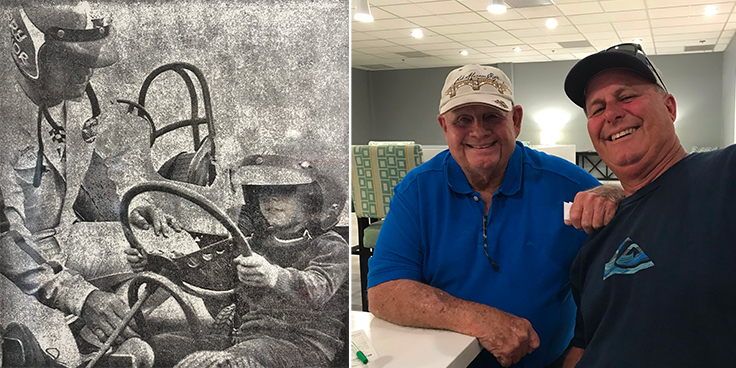
Minor’s passion for racing was passed on to his son, Chris, who was involved with his father for years both on and off the track.
Chris bought the sand drag cars from his father a few years ago, and even put NHRA Hot Rod Heritage Racing Series Funny Car champ Bibby Cotterll behind the wheel.
“My dad got out of it two or three years ago, and he was going to sell this stuff, and I said, ‘Just sell it to me, because I want to keep it going.’ I drove it for a while, and I didn't really like it, so Cory drove it, and Bobby did a lot of work on it for me and got the thing turned around and set a record," said Chris.
“A lot of these guys that are out there working today worked for my dad at one time or another. I remember Larry Dixon Jr. hanging around the race shop in 1986, and my dad put his car together and needed people. Mike Neff, same thing. He and I were buddies when we were kids, and I used to off-road race, and he’d come down to the shop while I was working on my trucks, and we built the ’91 dragster for Cruz. My dad asked him if he wanted a job, and that’s how it all started for him."
Although the Minors remain a farming family, they don't farm potatoes anymore but still have a lot of farmland that they manage, and Chris continues his father’s legacy in other ways.
“My dad enjoyed racing as a hobby when he first started,” Chris shared. “He just wanted to have fun, but when it got to become too big of a business, it kind of burned him out on having the big teams, but he was probably the modern-day pioneer of the multicar teams.
“He was just a legend. He loved racing. He loved farming and was very good at both. I worked for my father my whole life. He made me the man I am today. He was very stern and very hard to work for, but that just made me a better person. I think I really appreciate that now; probably the last 10 years have been the best 10 years of his and my life, because then we got to be together a lot.”
Larry Minor grew potatoes for a living, but what he was really good at was cultivating talent and helping people grow. Thanks, Larry. We’ll miss you.
Phil Burgess can be reached at pburgess@nhra.com
Hundreds of more articles like this can be found in the DRAGSTER INSIDER COLUMN ARCHIVE
Or try the Random Dragster Insider story generator





